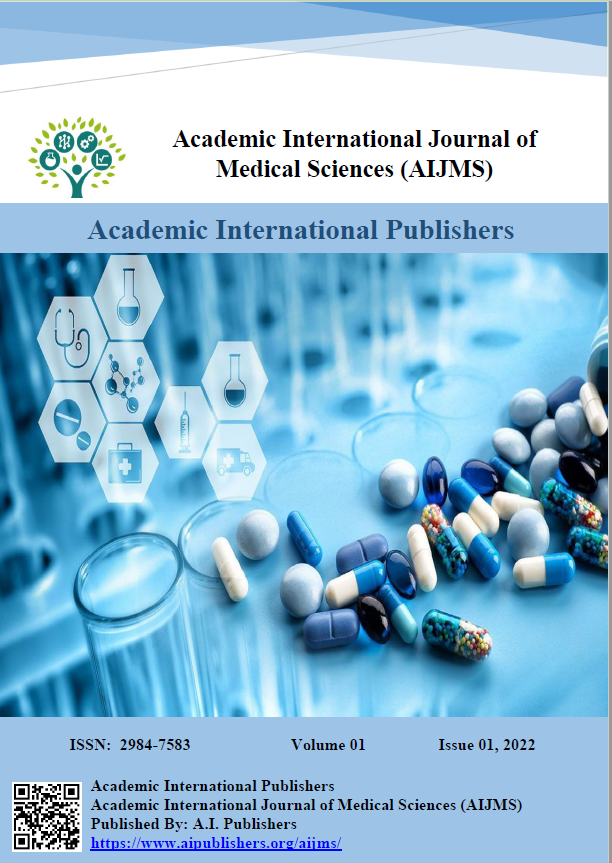Molecular Study of Enteropathogenic Escherichia Coli Isolation from Clinical Samples
DOI:
https://doi.org/10.59675/M2022-02Keywords:
molecular, characterises, Enteropathogenic, Escherichia coli isolation .Abstract
Escherichia coli regarded as the most important causes of intestinal illnesses in the world and also a significant public health challenge. Intestinal sicknesses which are caused by E. coli infection are often under diagnosed while doing usual microbiological analysis, particularly in resource constrained settings. However, the use of molecular tests could be helpful to identify the distribution of intestinal illnesses of E. coli infection and also its clinical importance.
The distribution analysis of virulence factors which exist among various E. coli pathotypes which include Shiga toxin-producing E. coli (STEC) will offer substantial insights with regard to the mechanisms through which various E. coli strains lead to diseases and result in the growth of different E. coli types. This present investigation therefore is an attempt to evaluate the incidence of intestinal illnesses of E. coli in clinical samples taken from patients. The samples from 150 patients and 15 controls were collected and then screened for E. coli. Compatible colonies taken from 150 individuals (150 patients and 15 controls) were characterized through performing biochemical test, a set of Polymerase Chain Reaction (PCR) for recognition of six virulence factors. The clinical samples from patients were within two months -two year attending. Pyelonephritis were associated by pili (pap gene, hemolysin (hly gene), aerobactin (aer gene), translocon pore-forming subunit espB and Shiga toxins (Stx1 and Stx2) respectively. They were related with six intestinal illnesses pathotypes. The incidence of hlyA and papC (both 40%) was highest, and was followed by espB, aer, stx1, stx2(30%,25%,20% and 18%) respectively. Although, how and whether these mixtures
of genes affect their pathogenicity is an issue that have to be investigated and elucidated. The findings obtained in this study highlight the significance of epidemiological and microbiological surveillance of STECs. It also determines if the development of control measures will diminish the risks which are associated with intestinal illnesses from E.coli.
References
Scheutz F, Nielsen EM, Frimodt-Møller J, Boisen N, Morabito S, Tozzoli R, et al. Characteristics of the enteroaggregative Shiga toxin/verotoxin-producing Escherichia coli O104:H4 strain causing the outbreak of haemolytic uraemic syndrome in Germany, May to June 2011. Eurosurveillance. 2011;16(24):19889.
Makvana S, Krilov LR. Escherichia coli infections. Pediatrics in Review. 2015;36(4):167-71.
Heng J, Zhao Y, Liu M, Liu Y, Fan J, Wang X, et al. Substrate-bound structure of the E. coli multidrug resistance transporter MdfA. Cell Research. 2015;25(9):1060-73.
Troeger C, Forouzanfar M, Rao PC, Khalil I, Brown A, Reiner Jr RC, et al. Estimates of global, regional, and national morbidity, mortality, and aetiologies of diarrhoeal diseases: a systematic analysis for the Global Burden of Disease Study 2015. Lancet Infect Dis. 2017;17(9):909-48.
Platts-Mills JA, Liu J, Rogawski ET, Kabir F, Lertsethtakarn P, Siguas M, et al. Use of quantitative molecular diagnostic methods to assess the aetiology, burden, and clinical characteristics of diarrhoea in children in low-resource settings: a reanalysis of the MAL-ED cohort study. Lancet Glob Health. 2018;6(12):e1309-18.
Umaru GA, Adamu Z, Ishaya D, Abubakar YU, Hussaini A, Umar M, et al. Prevalence and antimicrobial resistance pattern of Escherichia coli in drinking waters in Jalingo Metropolis, Taraba State, North-Eastern Nigeria. Microbiol Res Int. 2015;3(1):8-13.
van den Beld MJ, de Boer RF, Reubsaet FA, Rossen JW, Zhou K, Kuiling S, et al. Evaluation of a culture-dependent algorithm and a molecular algorithm for identification of Shigella spp., Escherichia coli, and enteroinvasive E. coli. J Clin Microbiol. 2018;56(10):e00510-18.
Deku JG, Duedu KO, Kinanyok S, Kpene GE, Feglo PK. Phylogenicity and virulence profiles of clinical Escherichia coli isolates in the Ho Teaching Hospital of Ghana. Biomed Res Int. 2022.
Hebbelstrup Jensen B, Olsen KE, Struve C, Krogfelt KA, Petersen AM. Epidemiology and clinical manifestations of enteroaggregative Escherichia coli. Clin Microbiol Rev. 2014;27(3):614-30.
Bryan A, Youngster I, McAdam AJ. Shiga toxin producing Escherichia coli. Clin Lab Med. 2015;35(2):247-72.
Bugarel M, Martin A, Fach P, Beutin L. Virulence gene profiling of enterohemorrhagic (EHEC) and enteropathogenic (EPEC) Escherichia coli strains: a basis for molecular risk assessment of typical and atypical EPEC strains. BMC Microbiol. 2011;11(1):1-10.
Awad WS, El-Sayed AA, Mohammed FF, Bakry NM, Abdou NEM, Kamel MS. Molecular characterization of pathogenic Escherichia coli isolated from diarrheic and in-contact cattle and buffalo calves. Trop Anim Health Prod. 2020;52(6):3173-85.
Zhang R, Wilson VL, Hou A, Meng G. Source of lead pollution, its influence on public health and the countermeasures. Int J Health Anim Sci Food Saf. 2015;2(1).
Espinosa I, Báez M, Percedo MI, Martínez S. Evaluation of simplified DNA extraction methods for Streptococcus suis typing. Rev Salud Anim. 2013;35(1):59-63.
Sarowska J, Futoma-Koloch B, Jama-Kmiecik A, Frej-Madrzak M, Ksiazczyk M, Bugla-Ploskonska G, et al. Virulence factors, prevalence and potential transmission of extraintestinal pathogenic Escherichia coli isolated from different sources: recent reports. Gut Pathog. 2019;11(1):1-16.
Kadhim NJ, AL-Karawi NJ, Almanseekanaa LH, Ogaili RH. Molecular characterization and antibiotic pattern of the Klebsiella pneumoniae. Vet Pract. 2021;22(2).
Al-Baer AS, Hussein AA. Optimum conditions for cytosine deaminase production by local isolate of Escherichia coli E9. World J Pharm Res. 2017;6(16):88-96.
Amani J, Ahmadpour A, Fooladi AA, Nazarian S. Detection of E. coli O157:H7 and Shigella dysenteriae toxins in clinical samples by PCR-ELISA. Braz J Infect Dis. 2015;19:278-84.
Liu H, Hua X, Zhang YN, Zhang T, Qu J, Nolte TM, et al. Electrocatalytic inactivation of antibiotic-resistant bacteria and control of antibiotic resistance dissemination risk. Environ Pollut. 2021;291:118189.
Gomes JF, Lopes A, Gonçalves D, Luxo C, Gmurek M, Costa R, et al. Biofiltration using C. fluminea for E. coli removal from water: comparison with ozonation and photocatalytic oxidation. Chemosphere. 2018;208:674-81.
•Rotariu O, Ogden ID, MacRitchie L, Forbes KJ, Williams AP, Cross P, et al. Combining risk assessment and epidemiological risk factors to elucidate the sources of human E. coli O157 infection. Epidemiol Infect. 2012;140(8):1414-29.
Downloads
Published
Issue
Section
License
Copyright (c) 2022 Academic International Journal of Medical Sciences

This work is licensed under a Creative Commons Attribution 4.0 International License.





